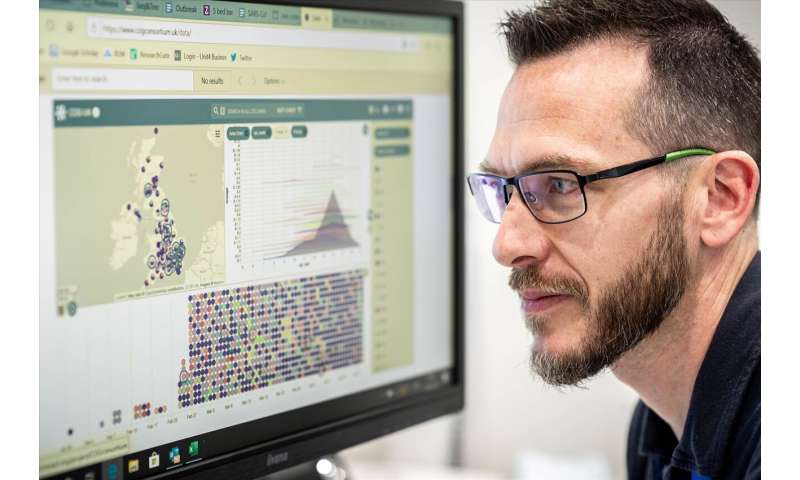
An in-depth analysis of the genome sequence of coronavirus circulating in Norfolk, UK by researchers at the Quadram Institute and University of East Anglia has mapped the spread of the virus, identified hidden outbreaks and provided insights into the effectiveness of interventions to stop its spread.
Over 1,500 COVID-19 genomes representing 42% of positive cases during the first wave of infections were sequenced for this study. Only Australia, Spain, India and the U.S. have sequenced more genomes than have been sequenced in Norfolk.
Positive coronavirus cases came from the region’s hospitals, community care organizations and drive through testing facilities, and were identified by testing by the National Health Service (NHS) Norfolk and Norwich University Hospital (NNUH) microbiology laboratory. They were sequenced and examined for tiny changes that indicate different types, or lineages, of the SARS-CoV-2 virus.
The team identified 100 different lineages in Norfolk, between March and August. There have been multiple separate introductions of the virus into the region, mainly from the UK or other European countries. The number of lineages peaked about five weeks after the national lockdown started, with many quickly disappearing, showing that the measures to prevent transmission were working.
Several additional findings were discovered when deeper analysis was performed: Analysis of samples from an outbreak within a food processing facility were all found to be very highly related, indicating that the virus was spreading between the factory workers. Identification of the outbreak lineage made it possible to trace the spread of the virus into the community and improve contact tracing efforts. This helps identify hidden routes of transmission.
Another lineage that appears to be associated only with a group of care homes, but not found in the wider community, has been identified and is currently under investigation.
A collection of hospital-associated cases was found to contain multiple lineages, giving confidence that these were infections picked up in the community, rather than an outbreak within the hospital.
As infections start to rise again, this shows the value of genome-based surveillance at the local level and in support of nationwide control measures.
The Norwich Research Park team is led by Dr. Justin O’Grady and Dr. Andrew Page, and is one of 19 partners in the UK’s COVID-19 Genomics UK Consortium that was set up in March to track the spread of the virus across the country.
The data are being shared with UK health agencies, as well as academics internationally, as part of the global effort to understand and control COVID-19.
Dr. Louise Smith, Director of Public Health, Norfolk County Council said: “It is very exciting that we can use cutting edge technologies such as viral genomic epidemiology to help us manage outbreaks on the ground in real time. It is immensely valuable to be able to identify whether an outbreak is due to a new introduction of the virus or linked to local cases; and conversely to be able to track the progression of outbreaks out into the general community. I very much appreciate and value this collaboration.”
“We believe that this gives Norfolk one of the highest genome sequence coverage rates per capita in the world” said Dr. Justin O’Grady from the Quadram Institute and the University of East Anglia. “Viral genome sequencing provides much greater resolution than traditional epidemiological methods allowing us to distinguish between different clusters. This is vital information, especially as we move into a second peak of infections.”
“We have quickly put in place a robust, rapid pipeline for SARS-CoV-2 sequencing, with weekly sequencing data fed back into the national effort for pandemic management, whilst also helping local outbreak analyzes” said Dr. Andrew Page from the Quadram Institute. “These achievements were only possible through the collaborative efforts of scientists, clinicians, data managers and epidemiologists”
“The COG-UK initiative to provide whole genome sequencing of SARS-CoV-2 provides improvement in hospital functioning by aiding IPC efforts and clarifying intra-hospital transmission events as well as reduction of transmission of the virus from hospitals to the community” said Dr. Samir Dervisevic, Consultant Virologist at NNUH
“In addition, the Quadram Institute researchers working in partnership with Norfolk and Norwich University Hospital virologists and Infection Prevention Control team are about to commence an adjunctive sequencing study which will enable rapid identification of hospital spread of SARS-CoV-2 within 24 hours. The rapid deployment of genome sequencing in outbreak situations would greatly aid the effort to reduce the risk of the spread of infection amongst our vulnerable patients as well the staff. This type of intervention would not only help patient management but would provide as accurate as possible analysis of intra-hospital transmission.”
Matching patterns seen elsewhere, most samples came from older people, with only a handful from children. More samples were obtained from females than males, reflecting longer life expectancy patterns but also the large proportion of the NHS workforce who are female.
Source: Read Full Article
